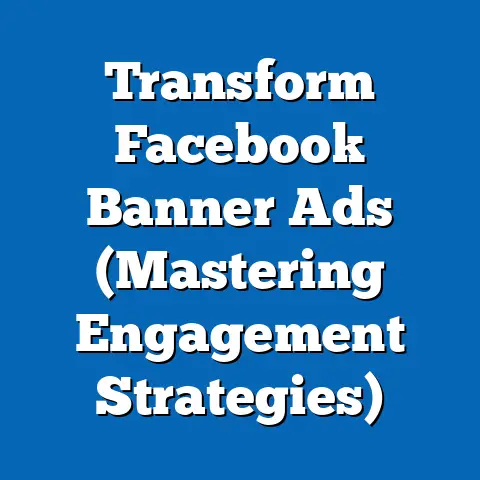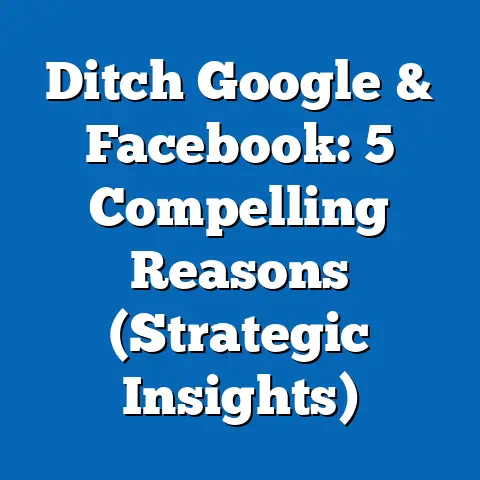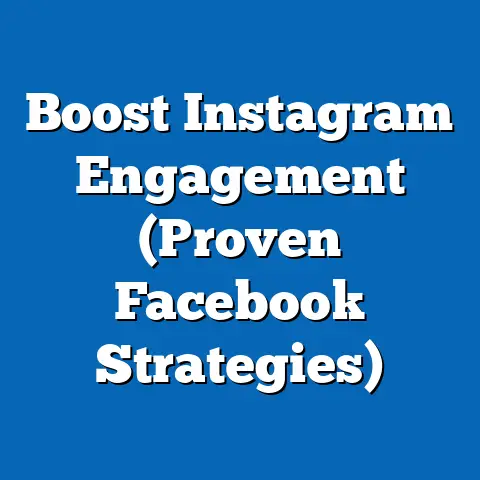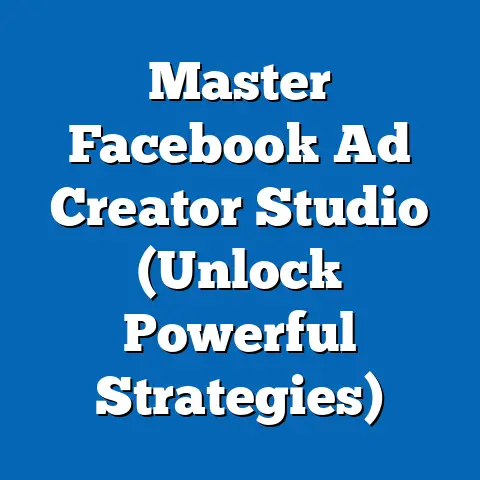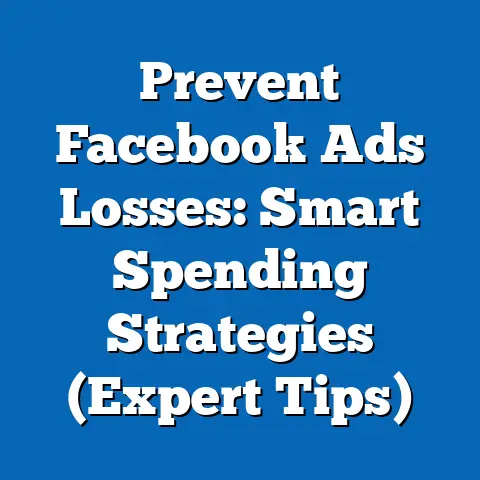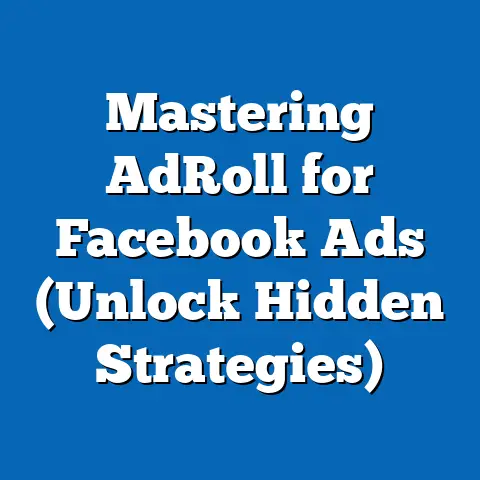Unlock Facebook Ad Pricing Secrets (Insider Strategies)
As of 2023, Facebook ads accounted for over 23% of all digital ad spending globally. That’s a staggering figure, translating to billions of dollars in revenue for businesses that understand and effectively leverage this powerful platform. But with great power comes great responsibility – and in the realm of Facebook advertising, that responsibility means understanding the often-complex world of ad pricing.
I’ve spent years navigating the Facebook advertising landscape, and I’ve seen firsthand how a solid grasp of pricing can make or break a campaign. Too many businesses throw money at Facebook ads without truly understanding where their budget is going or how to optimize their spending for maximum return. That’s where this guide comes in.
This article isn’t just about understanding the basics; it’s about unlocking the insider strategies that can help you navigate the complexities of Facebook ad pricing, reduce costs, and ultimately, maximize your ROI. We’ll dive into the different pricing models, explore the factors that influence your ad costs, and reveal actionable techniques that you can implement today. Let’s get started!
Understanding Facebook Ad Pricing Structures
Facebook doesn’t have a one-size-fits-all price tag. Instead, it offers a variety of pricing models, each tailored to different campaign objectives and target audiences. Choosing the right model is crucial for ensuring that you’re paying for the results that matter most to your business. Here’s a breakdown of the most common pricing structures:
-
Cost Per Click (CPC): This is perhaps the most straightforward model. You pay each time someone clicks on your ad, regardless of whether they make a purchase, fill out a form, or take any other specific action. CPC is ideal for driving traffic to your website or landing page.
-
Cost Per Mille (CPM): “Mille” is Latin for “thousand,” so CPM means you pay for every 1,000 impressions your ad receives. An impression is simply when your ad is displayed to a user, whether or not they click on it. CPM is best suited for brand awareness campaigns where your primary goal is to get your message in front of as many people as possible.
-
Cost Per Action (CPA): This model is results-oriented. You only pay when someone takes a specific action, such as making a purchase, downloading an app, or submitting a lead form. CPA is great for campaigns focused on generating leads or driving conversions.
-
Cost Per Engagement (CPE): With CPE, you pay when a user engages with your ad in some way, such as liking, commenting, sharing, or watching a video. This model is perfect for campaigns aimed at boosting engagement and building a community around your brand.
Cost Per Click (CPC): This is perhaps the most straightforward model. You pay each time someone clicks on your ad, regardless of whether they make a purchase, fill out a form, or take any other specific action. CPC is ideal for driving traffic to your website or landing page.
Cost Per Mille (CPM): “Mille” is Latin for “thousand,” so CPM means you pay for every 1,000 impressions your ad receives. An impression is simply when your ad is displayed to a user, whether or not they click on it. CPM is best suited for brand awareness campaigns where your primary goal is to get your message in front of as many people as possible.
Cost Per Action (CPA): This model is results-oriented. You only pay when someone takes a specific action, such as making a purchase, downloading an app, or submitting a lead form. CPA is great for campaigns focused on generating leads or driving conversions.
Cost Per Engagement (CPE): With CPE, you pay when a user engages with your ad in some way, such as liking, commenting, sharing, or watching a video. This model is perfect for campaigns aimed at boosting engagement and building a community around your brand.
Why Does This Matter?
Imagine you’re a local bakery trying to drive foot traffic to your store. A CPC campaign might be effective, as you’re paying for users who are interested enough to click on your ad and potentially visit your website for your location. On the other hand, if you’re launching a new line of organic breads and want to get the word out to the community a CPM campaign may be the best option.
My Experience: I once worked with a small e-commerce business that was struggling to generate sales with their Facebook ads. They were using a CPC model, but their website conversion rate was low. After switching to a CPA model and optimizing their landing page for conversions, they saw a significant increase in sales and a much better return on their ad spend.
Takeaway: The key is to align your pricing model with your campaign objectives. Don’t just choose the cheapest option; choose the one that will deliver the most valuable results for your business.
Factors Influencing Facebook Ad Costs
While understanding the different pricing models is essential, it’s equally important to understand the factors that influence the actual cost of your ads. Facebook’s ad auction system is complex, and several variables can affect how much you pay. Here’s a look at some of the most significant factors:
-
Audience Targeting: The more specific and targeted your audience, the higher your ad costs are likely to be. Targeting a niche audience with specific interests and demographics means you’re competing with other advertisers who are also trying to reach those same people. Conversely, a broader audience may be cheaper to reach, but your ads may be less effective.
-
Ad Quality and Relevance Score: Facebook rewards high-quality, relevant ads with lower costs and better placement. Your ad’s relevance score is a metric that measures how well your ad resonates with your target audience. The higher the score, the lower your costs are likely to be. Factors that influence your relevance score include the quality of your ad creative, the clarity of your messaging, and the overall user experience.
-
Competition in the Ad Auction: Facebook’s ad auction is a dynamic system where advertisers bid against each other to display their ads to users. The more advertisers competing for the same audience, the higher the costs will be. Competition can fluctuate based on industry, seasonality, and other factors.
-
Seasonal Trends and Demand Fluctuations: Like any marketplace, Facebook’s ad prices can be affected by seasonal trends and demand fluctuations. For example, ad costs tend to be higher during the holiday season when more businesses are advertising. Similarly, costs may be higher during specific events or promotions.
Audience Targeting: The more specific and targeted your audience, the higher your ad costs are likely to be. Targeting a niche audience with specific interests and demographics means you’re competing with other advertisers who are also trying to reach those same people. Conversely, a broader audience may be cheaper to reach, but your ads may be less effective.
Ad Quality and Relevance Score: Facebook rewards high-quality, relevant ads with lower costs and better placement. Your ad’s relevance score is a metric that measures how well your ad resonates with your target audience. The higher the score, the lower your costs are likely to be. Factors that influence your relevance score include the quality of your ad creative, the clarity of your messaging, and the overall user experience.
Competition in the Ad Auction: Facebook’s ad auction is a dynamic system where advertisers bid against each other to display their ads to users. The more advertisers competing for the same audience, the higher the costs will be. Competition can fluctuate based on industry, seasonality, and other factors.
Seasonal Trends and Demand Fluctuations: Like any marketplace, Facebook’s ad prices can be affected by seasonal trends and demand fluctuations. For example, ad costs tend to be higher during the holiday season when more businesses are advertising. Similarly, costs may be higher during specific events or promotions.
How to Assess These Factors
Assessing these factors requires a combination of data analysis and strategic thinking.
- Audience Targeting: Use Facebook’s Audience Insights tool to research your target audience and identify their interests, demographics, and behaviors. This can help you refine your targeting and reduce wasted ad spend.
- Ad Quality and Relevance Score: Pay close attention to your ad’s relevance score in Facebook Ads Manager. Experiment with different ad creatives, copy, and targeting options to improve your score.
- Competition in the Ad Auction: Monitor your ad costs and performance over time to identify trends and fluctuations. This can help you adjust your bidding strategy and optimize your campaigns for maximum efficiency.
- Seasonal Trends and Demand Fluctuations: Plan your campaigns in advance and adjust your budget accordingly. Be prepared to pay more during peak seasons and consider running campaigns during off-peak times to take advantage of lower costs.
My Experience: I once managed a campaign for a clothing retailer during the holiday season. Ad costs were significantly higher than usual due to increased competition. To combat this, we focused on creating highly targeted ads with compelling offers and optimized landing pages. We also experimented with different ad formats, such as carousel ads and video ads, to capture users’ attention and improve our relevance score.
Takeaway: Understanding the factors that influence Facebook ad costs is essential for developing a cost-effective advertising strategy. By carefully assessing these factors and adjusting your campaigns accordingly, you can minimize your costs and maximize your ROI.
Insider Strategies for Reducing Costs and Maximizing Results
Now that we’ve covered the basics of Facebook ad pricing, let’s dive into some actionable strategies that you can implement to reduce costs and maximize results. These strategies are based on my own experience and the experiences of other successful advertisers.
-
Optimize Ad Creatives and Copy for Better Engagement: High-quality ad creatives and compelling copy are essential for capturing users’ attention and driving engagement. Use eye-catching visuals, clear and concise messaging, and a strong call to action. Test different ad variations to see what resonates best with your target audience.
-
Utilize A/B Testing to Identify High-Performing Ads: A/B testing is a powerful technique for identifying the most effective ad variations. Create multiple versions of your ads with different headlines, images, and calls to action. Run these ads simultaneously and track their performance. The winning ad is the one that generates the most clicks, conversions, or engagement at the lowest cost.
-
Leverage Retargeting Campaigns to Reach Users Who Are Already Familiar with the Brand: Retargeting is a strategy that allows you to show ads to users who have already interacted with your website, app, or Facebook page. These users are more likely to be interested in your products or services, making them a valuable audience to target. Retargeting campaigns can be highly effective at driving conversions and increasing ROI.
-
Schedule Ads for Optimal Times Based on Audience Online Behavior: Your target audience is more likely to be online and engaged at certain times of the day and days of the week. Use Facebook’s ad scheduling feature to show your ads during these optimal times. This can help you reach more users and improve your ad performance.
Optimize Ad Creatives and Copy for Better Engagement: High-quality ad creatives and compelling copy are essential for capturing users’ attention and driving engagement. Use eye-catching visuals, clear and concise messaging, and a strong call to action. Test different ad variations to see what resonates best with your target audience.
Utilize A/B Testing to Identify High-Performing Ads: A/B testing is a powerful technique for identifying the most effective ad variations. Create multiple versions of your ads with different headlines, images, and calls to action. Run these ads simultaneously and track their performance. The winning ad is the one that generates the most clicks, conversions, or engagement at the lowest cost.
Leverage Retargeting Campaigns to Reach Users Who Are Already Familiar with the Brand: Retargeting is a strategy that allows you to show ads to users who have already interacted with your website, app, or Facebook page. These users are more likely to be interested in your products or services, making them a valuable audience to target. Retargeting campaigns can be highly effective at driving conversions and increasing ROI.
Schedule Ads for Optimal Times Based on Audience Online Behavior: Your target audience is more likely to be online and engaged at certain times of the day and days of the week. Use Facebook’s ad scheduling feature to show your ads during these optimal times. This can help you reach more users and improve your ad performance.
Case Study: Local Restaurant Chain
I recently worked with a local restaurant chain that was struggling to generate consistent sales with their Facebook ads. After analyzing their data, I realized that their ads were running at all hours of the day, regardless of when their target audience was most likely to be online.
I recommended that they schedule their ads to run during peak dining hours, such as lunch and dinner. I also helped them create targeted ads with mouthwatering photos of their food and compelling offers. As a result, they saw a significant increase in sales and a much better return on their ad spend.
Takeaway: By implementing these insider strategies, you can significantly reduce your Facebook ad costs and maximize your results. The key is to focus on creating high-quality ads, targeting the right audience, and optimizing your campaigns for maximum efficiency.
Leveraging Facebook Ad Tools and Features
Facebook offers a suite of powerful tools and features that can help you manage your ad costs and optimize your campaigns for maximum ROI. Here’s a look at some of the most important tools:
-
Facebook Ads Manager: This is your central hub for creating, managing, and tracking your Facebook ad campaigns. Ads Manager provides a wealth of data and insights that can help you understand your ad performance and make informed decisions about your bidding strategy, targeting, and ad creatives.
-
Audience Insights: As mentioned earlier, Audience Insights is a valuable tool for researching your target audience and identifying their interests, demographics, and behaviors. This information can help you refine your targeting and reduce wasted ad spend.
-
Automated Rules: This feature allows you to set up rules that automatically pause, adjust, or scale your campaigns based on performance metrics. For example, you can set up a rule to automatically pause your ads if their cost per click exceeds a certain threshold. Automated rules can save you time and effort while ensuring that your campaigns are always running efficiently.
Facebook Ads Manager: This is your central hub for creating, managing, and tracking your Facebook ad campaigns. Ads Manager provides a wealth of data and insights that can help you understand your ad performance and make informed decisions about your bidding strategy, targeting, and ad creatives.
Audience Insights: As mentioned earlier, Audience Insights is a valuable tool for researching your target audience and identifying their interests, demographics, and behaviors. This information can help you refine your targeting and reduce wasted ad spend.
Automated Rules: This feature allows you to set up rules that automatically pause, adjust, or scale your campaigns based on performance metrics. For example, you can set up a rule to automatically pause your ads if their cost per click exceeds a certain threshold. Automated rules can save you time and effort while ensuring that your campaigns are always running efficiently.
How to Use These Tools Effectively
Using these tools effectively requires a combination of technical skills and strategic thinking.
- Facebook Ads Manager: Take the time to learn all of the features and functionalities of Ads Manager. Experiment with different bidding strategies, targeting options, and ad creatives. Track your ad performance closely and make adjustments as needed.
- Audience Insights: Use Audience Insights to research your target audience and identify their interests, demographics, and behaviors. This information can help you refine your targeting and create ads that resonate with your audience.
- Automated Rules: Set up automated rules to monitor your ad performance and make adjustments as needed. This can help you save time and effort while ensuring that your campaigns are always running efficiently.
My Experience: I once worked with a startup that was launching a new mobile app. They had a limited budget for their Facebook ad campaign, so I helped them set up automated rules to ensure that their ads were always running efficiently. We set up rules to automatically pause ads that were underperforming and to scale up ads that were generating a high return on investment. As a result, they were able to maximize their budget and generate a significant number of app downloads.
Takeaway: Facebook’s ad tools and features can be incredibly valuable for managing your ad costs and optimizing your campaigns. By taking the time to learn how to use these tools effectively, you can significantly improve your ROI.
Future Trends in Facebook Ad Pricing
The world of Facebook advertising is constantly evolving, and it’s important to stay up-to-date on the latest trends and developments. Here are some emerging trends that could have a significant impact on Facebook ad pricing in the future:
-
The Rise of AI-Driven Ad Placement and Optimization: Facebook is increasingly using artificial intelligence (AI) to automate ad placement and optimization. AI algorithms can analyze vast amounts of data to identify the most effective ad placements, bidding strategies, and targeting options. This could lead to more efficient ad spending and lower costs for advertisers.
-
Changes in User Privacy Regulations and Their Implications for Targeting: User privacy is a growing concern, and governments around the world are implementing new regulations to protect user data. These regulations could limit the amount of data that Facebook can collect and use for ad targeting, which could make it more difficult and expensive to reach specific audiences.
-
The Growing Importance of Ad Format Diversity (e.g., Video, Stories, Carousel Ads): Facebook offers a variety of ad formats, including video ads, stories ads, and carousel ads. These formats can be more engaging and effective than traditional image ads, and they may become increasingly important in the future. Advertisers who are able to master these formats may be able to achieve better results at a lower cost.
The Rise of AI-Driven Ad Placement and Optimization: Facebook is increasingly using artificial intelligence (AI) to automate ad placement and optimization. AI algorithms can analyze vast amounts of data to identify the most effective ad placements, bidding strategies, and targeting options. This could lead to more efficient ad spending and lower costs for advertisers.
Changes in User Privacy Regulations and Their Implications for Targeting: User privacy is a growing concern, and governments around the world are implementing new regulations to protect user data. These regulations could limit the amount of data that Facebook can collect and use for ad targeting, which could make it more difficult and expensive to reach specific audiences.
The Growing Importance of Ad Format Diversity (e.g., Video, Stories, Carousel Ads): Facebook offers a variety of ad formats, including video ads, stories ads, and carousel ads. These formats can be more engaging and effective than traditional image ads, and they may become increasingly important in the future. Advertisers who are able to master these formats may be able to achieve better results at a lower cost.
Preparing for the Future
To prepare for these trends, advertisers should:
- Embrace AI-Driven Ad Optimization: Learn how to use Facebook’s AI-powered tools to automate ad placement and optimization.
- Focus on First-Party Data: Collect and leverage your own first-party data to target your audience more effectively.
- Experiment with Different Ad Formats: Test different ad formats to see what resonates best with your target audience.
My Prediction: I believe that AI will play an increasingly important role in Facebook advertising in the future. Advertisers who are able to embrace AI-driven ad optimization will have a significant advantage over those who don’t.
Takeaway: The future of Facebook ad pricing is uncertain, but advertisers who are able to stay ahead of the curve and adapt to new trends will be well-positioned to succeed.
Conclusion
Understanding Facebook ad pricing is crucial for any business that wants to achieve a positive ROI on their advertising spend. By understanding the different pricing models, the factors that influence ad costs, and the strategies that you can use to reduce costs and maximize results, you can take control of your Facebook ad campaigns and achieve your business goals.
I’ve shared my experiences, insights, and actionable strategies in this guide. Now, it’s your turn to take action. Implement these strategies in your own Facebook ad campaigns and track your results. Don’t be afraid to experiment and try new things. The key is to be data-driven, adaptable, and always learning.
I invite you to share your own experiences and insights related to Facebook ad pricing in the comments section below. What strategies have worked for you? What challenges have you faced? Let’s learn from each other and help each other succeed in the ever-evolving world of Facebook advertising.
Now go forth and conquer the Facebook ad landscape!

